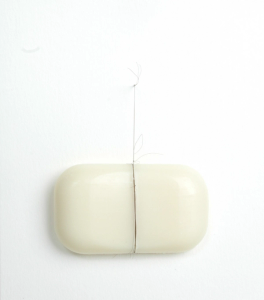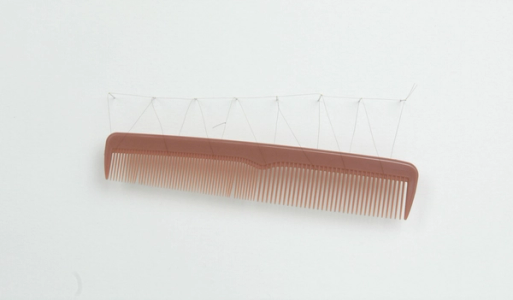
Areej Kaoud
Anxiety, 2017
Areej Kaoud spent part of her childhood in Gaza, before her family was able to emigrate to Canada. She remembers her mother’s focus on the preservation of their roots after their move. While the family had to learn French as a third language, at home only Arabic was allowed. Looking back, Kaoud is grateful for this maternal persistence, which allowed her to become engaged in political conversations about ‘home’ from a young age.
The balloon installation of the word ‘anxiety’, is part of a larger piece that Areej made in 2017 entitled: Anxiety Is a Present of the Present.
‘Derived from my interest in emergencies and disaster scenarios, this piece focuses on anxiety as a measure of safety, articulating it as a readily available emergency provision. It is a psychological state frequently hovering and retains power in its fragility. Writing is a prominent medium in my art practice, and this phrase simply resonates within me as a true sentiment regarding anxiety. This large-scale installation presents 29 letters filled with helium, 24 rocks, and cotton strings.’

Kaoud kept the word ‘anxiety’ from the larger work and reinstalled it in her garden, allowing her to see her floating work every day. As anxiety is a common feeling for her, Kaoud figured that she might as well start celebrating it. In combination with the ‘Free Palestine’ sign in her window, Anxietyoccasionally stimulates passersby to ring the doorbell for a chat. This idea of emergency psychology is a leitmotif in Kaoud’s practice, one she mixes with more playful approaches to create a sense of comfort. Areej sees her psychological work not as a solution or a coping mechanism, but rather as her duty, her contribution to the narrative. She feels her work is about expressing the journey that consists of continuous attempts to find safety.
‘I’m always in a state in which I’m preparing for the worst. I am anticipating finding myself in a state of numbness, freezing. This is why I’m so fascinated by safety provisions.’

In her 2014 work Durability Studies, Kaoud is testing the durability and social value of a human hair removed from the body. She is interested not in the human aspect of hair, but rather its meaning once it is detached from the body. This inquiry into the physical nature of hair dates back to the beginning of her artistic practice when she found her style by using relatable, playful objects as media for deeper messages. By allowing the concept to choose the object, she prevents her work from becoming too attached to one specific medium.

Areej Kaoud is a Palestinian visual artist working with writing, recording, performance, data accumulation and installation. Her practice draws on her interest in narratives and disaster scenarios, as well as diaspora psychology and emergency behaviour.
Interview by Clara Wouters